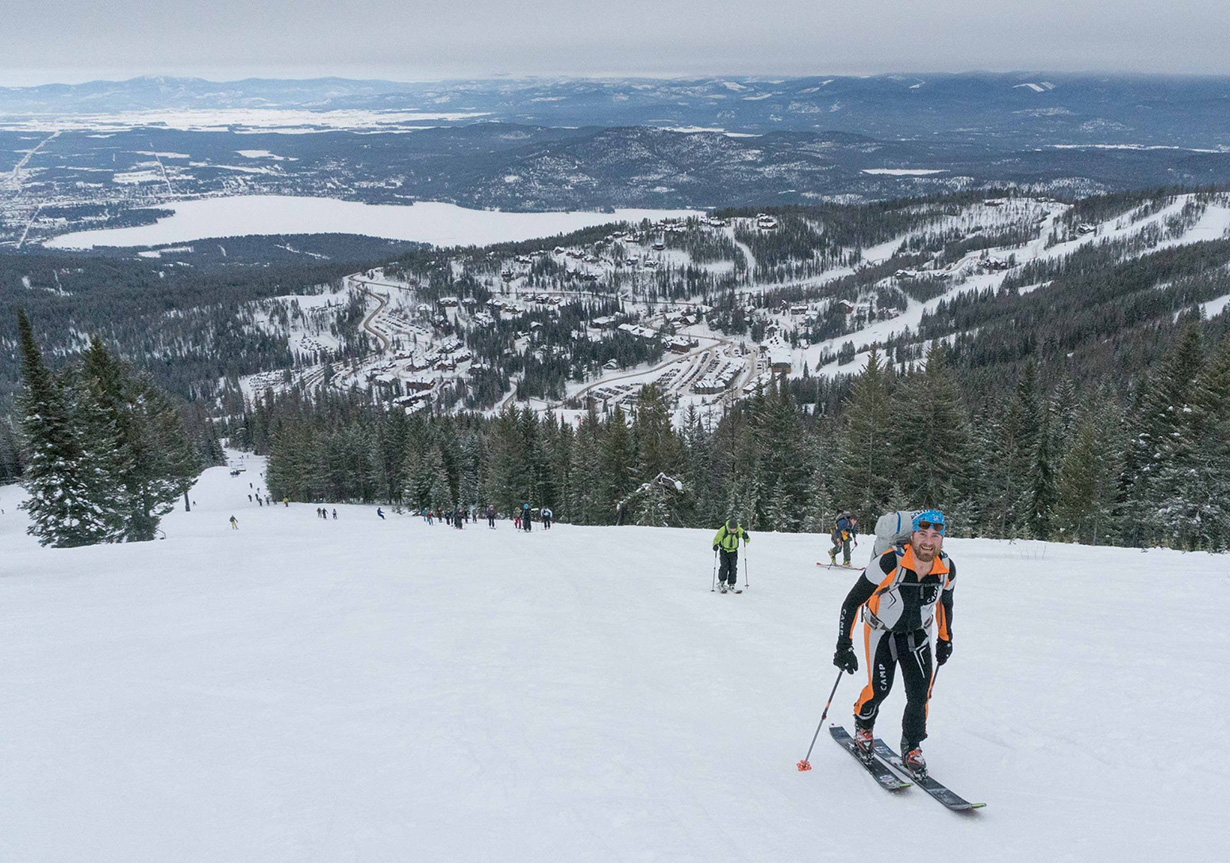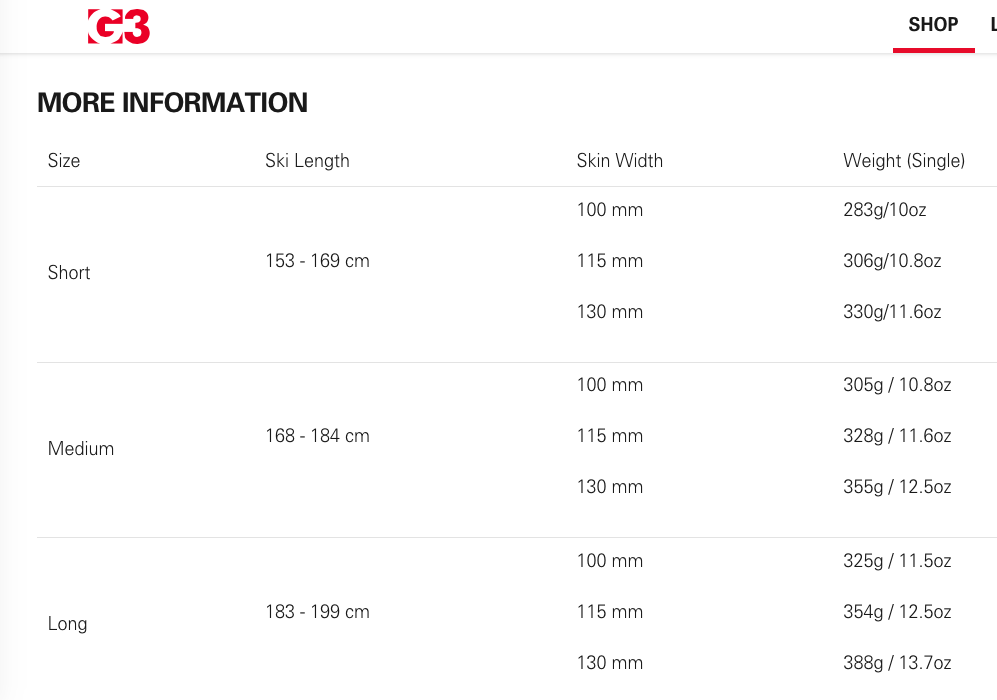
G3 Scala Skin
MSRP: $215.95
Skis Used: ON3P Steeple 108, 184 cm
Days Tested: 29
Test Locations: NW Montana backcountry & Glacier National Park, MT; Rogers Pass, BC; Logan Canyon, UT
Intro
Tip rocker is now a common feature on nearly every ski in the wider, powder-oriented touring category. But given the way that climbing skins work — they require contact with the snow to grip plus some weight behind that contact to produce traction — significant rocker profiles create a bit of a problem, as the design pulls the skin plush away from the snow.
So new rocker shapes + old skin designs, while breaking trail in new snow, have a large section of plush on the front of the ski doesn’t create traction. The ski must plane up out of the depression of the last step, with the useless skin material causing more friction.
With this in mind, G3 created the Scala. The plush up front is replaced by a slippery, urethane piece that extends off the tip attachment, and is then attached to G3’s classic Alpinist nylon plush. Instead of resistance, the plastic is supposed to offer a fast, non-glopping, quick-planing option that should theoretically make trail breaking in deep snow better.
So … does it work?
Features
Starting at the back, the Scala shares most of its traits with the G3 Alpinist. Their cam tail connector clips onto the back of most ski shapes, making for easy transitions even when wearing mittens.
The factory-sliced bikini cut in the tail offers a neat finish to the plush, and it resists snow incursion under the plush while thrashing around in kick turns. 100% nylon plush goes forward from there, offering the durable, grippy characteristics common to nylon skins.
But at the very front, things get different. G3’s “Hybrid Tip Connector” is an elongated version of their usual, urethane tip connector that slides more easily than any nylon or mohair.. A grip/scale pattern is cut into the urethane and ridges behind work to prevent snow creep. Beveled edges deflect snow from the sides, and the rotating metal hands attach to any ski tip
shape.
Breaking Trail
With the Scala, G3 was looking to solve a couple of specific problems (e.g., tip drag while breaking trail, glue failure in the tips) related to wider skis with significant tip rocker in soft, deeper snow. Since it seems purpose-built for putting in a skin track in deep snow, I was happy to find that the Scala works just fine in this application.

Each step forward sees the ski rise out of the snow quickly and hold well once back down in the fluff. I’ve had zero issues with skin failure from snow infiltrating beneath my tip glue; chalk that up to the beveled edges and excellent tip / tail connectors.
But I’ve yet to feel like the Scala makes a significant difference in the amount of effort spent over the course of a long day of breaking trail. Other friends who use the Scala have reported similar findings. My feeling is that it certainly helps, since everything about the design makes sense. But I can’t say that I felt a major difference using the Scala over a regular skin.
Sizing
Like G3’s other skin options, taking the time to correctly size your skis to the skins is an essential part of the purchase process.
More than any other skin I’ve used, the Scala offers a large range of adjustment in the tail strap. A plus here is that if you are looking to share the skin between two skis of similar shapes but different lengths, the G3 tail connector helps you do that.

The downsides here include way too much flapping tail straps (I cut mine down) and, if the skin isn’t sized right, you’ll end up with a large area of base in the tail that doesn’t get covered in plush. If you’re looking to use the Scala on a ski that has a fairly flat tail, pay extra attention here.
Going to a shop and actually trying the skins on your skis is the best way to make sure you get what you want.
Installation / the Skin-Trimming Process
Hats off to G3 for making the skin-trimming process so easy. If you sized right, pull off the contact sheets, attach the skin, and with four easy swipes of the included trim tool, you’re ready to go. It cuts the Hybrid Tip Connector, too; trim from tail to tip to make that part easier. It doesn’t get much simpler than this.
Packability
Done right, the Scala can be less of an obstacle in your pack than many other skins on the market.
Done wrong, it’s a huge hassle.
G3 recommends folding the skin around the Hybrid Tip Connector in what I can only call a sort of a spiral configuration with the urethane at the center.
I also tested my typical method, which is to simply fold the skin in half and stick glue to glue.
Recently, I’ve used both the Patagonia Ascensionist 35 and BCA Float packs for uphill ski days. The Float bags all have dedicated tool compartments that easily accept the Scalas in their folded configuration. The Ascentionist 35 doesn’t. So sliding the folded Scalas into the Ascentionist 35 requires careful packing (e.g., stuff sacks of gear in the center, avy tools on the sides, shovel blade parallel to the pack frame on the rear wall of the compartment) and then sandwiching the skins between the shovel blade and the fabric of the bag.
I’ve found out on plenty of single-digit days this season that cold temperatures stiffen the urethane of the Hybrid Tip Connector. So rolling the Scalas to fit into an overstuffed pack simply doesn’t work, as the Scala tries to uncoil. They also don’t roll down to fit into a jacket, and the Scala section is long enough that they don’t fit in most jacket’s skin pockets when folded the way G3 suggests (Jonathan Ellsworth concurs). So if you’re a jacket or top-of-your-pants skin storage person, you’d best look elsewhere.
NEXT: Glide, Grip, and Glopping, Durability, Etc
